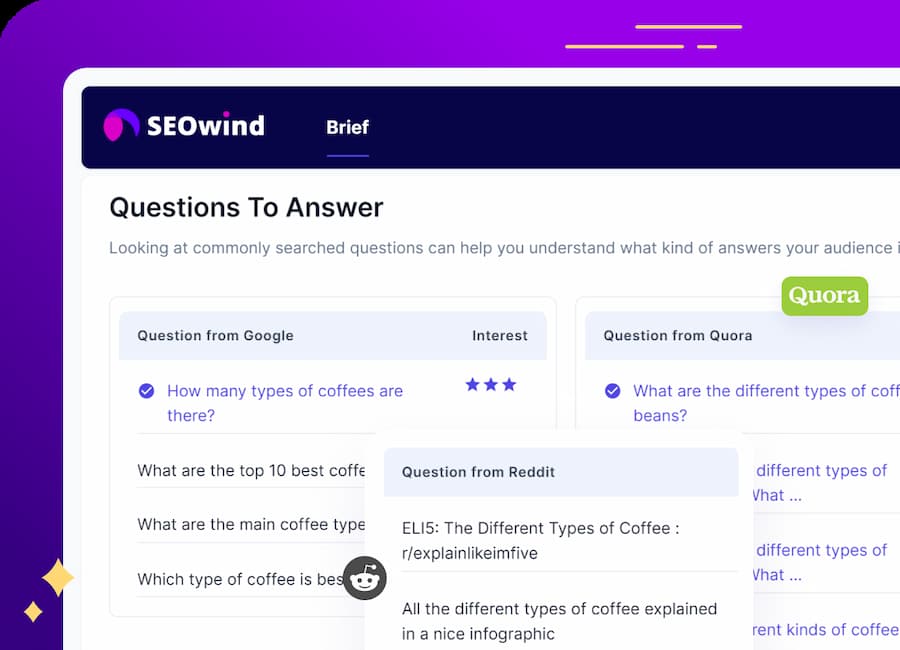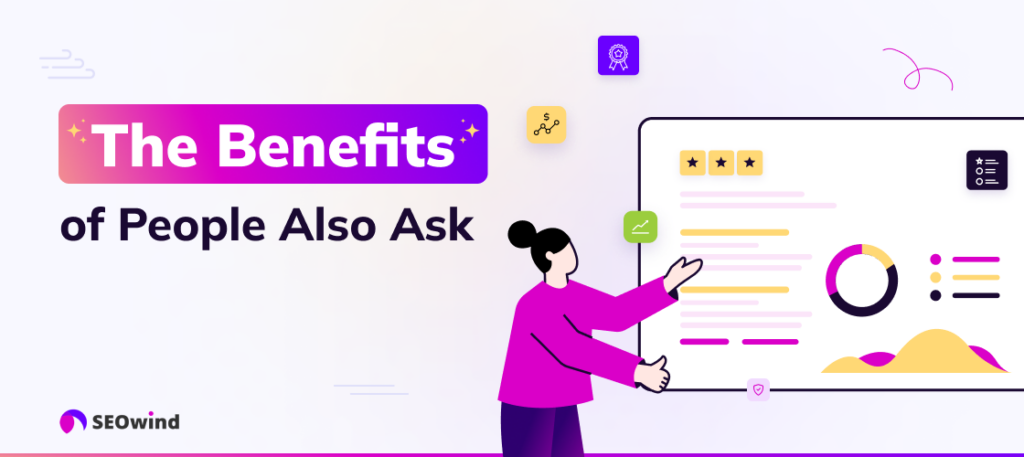Unravel the mystery of Google’s People Also Ask and discover how this feature can elevate or hinder your SEO strategy.

Image courtesy of via DALL-E 3
Table of Contents
Introduction to Google’s People Also Ask
Google is a popular search engine that helps you find information on pretty much anything you can think of. But have you ever noticed a section called “People Also Ask” when you search for something? Well, that’s what we’re going to talk about today – Google’s People Also Ask feature, often referred to as PAA. So, let’s dive in and learn more about what it is and why it’s essential for SEO.
What is Google’s PAA?
When you search for something on Google, the People Also Ask section shows up with questions related to your search. These questions expand when clicked on, providing more information. Google uses artificial intelligence to predict what questions users might have based on their initial search query. This feature aims to make your search experience more informative and efficient.
Why Does PAA Matter?
Now, you might be wondering why this People Also Ask feature is essential, especially for websites and businesses. Well, when a website’s content appears in the PAA section, it gets more visibility to people searching for related information. This increased visibility can drive more traffic to the website, ultimately benefiting its SEO (Search Engine Optimization) efforts.
How PAA Works
Google’s People Also Ask (PAA) feature works by displaying a list of related questions that users commonly ask when they search for a specific topic. Google uses complex algorithms to analyze the relevance of each question to the initial search query. The questions shown in the PAA section are chosen based on their likelihood of being helpful to users based on search patterns and user behavior.
Answer Boxes in PAA
When you search for a topic on Google, you may notice a box that provides a direct answer to a particular question related to the search query. These are called answer boxes, and they are part of the PAA feature. The answers displayed in these boxes are pulled from relevant websites that Google determines have valuable and concise information to address the query. Answer boxes are designed to offer immediate assistance to users without having to click through to a website.
Benefits of Appearing in PAA
Appearing in Google’s People Also Ask (PAA) boxes can offer numerous benefits for websites looking to enhance their online presence. Let’s explore some of the advantages that come with being featured in this prominent search feature.

Image courtesy of wpslimseo.com via Google Images
Increased Visibility
When your website’s content appears in the PAA section of Google search results, it receives prime visibility to users actively seeking information on a particular topic. This increased exposure can help enhance brand recognition and attract more visitors to your site.
Boost in Organic Traffic
Being featured in the People Also Ask section can drive a significant increase in organic traffic to your website. Users are more likely to click on an answer directly provided by Google, leading them to visit your site for further information. This boost in traffic can ultimately result in higher engagement and conversions.
Authority and Credibility
Having your content showcased in PAA can help establish your website as a trusted source of information in your industry. Users are more likely to perceive your site as authoritative when Google highlights your content in response to their queries. This recognition can build trust and credibility, leading to a loyal audience base.
Optimizing Content for PAA
In order to increase your chances of having your content featured in Google’s People Also Ask (PAA) section, it’s crucial to optimize your content specially for this purpose. By understanding how to create content that aligns with the PAA criteria, you can enhance your visibility, drive more organic traffic, and build authority and credibility. Here are some tips on how to optimize your content for PAA:
Keyword Research
One of the most important aspects of optimizing content for PAA is conducting thorough keyword research. Utilize tools and research methods to identify the right questions that users are asking related to your topic. By targeting these specific queries, you increase your chances of being featured in the PAA section.
Structured Content
Creating well-organized content with clear headings and subheadings is essential for PAA optimization. Google tends to select answers that are structured and easy to read. By organizing your content in a clear and logical manner, you make it more likely to be chosen for the PAA box.
Answering Questions Directly
When optimizing your content for PAA, make sure to provide direct and concise answers to common queries. Google prefers answers that directly address the user’s question in a clear and succinct manner. By focusing on answering questions directly, you increase your chances of being featured in the PAA section.
Tracking PAA Performance
In order to monitor how well your content is performing in Google’s People Also Ask (PAA) feature, it is crucial to utilize various tools that provide valuable insights into its visibility and impact on your SEO efforts. By tracking PAA performance, you can make informed decisions on optimizing your content to maximize its presence in search results.

Image courtesy of seowind.io via Google Images
Using Google Search Console
One of the most effective tools for tracking your content’s performance in PAA is Google Search Console. This free tool provided by Google offers valuable data on how your website is performing in search results, including PAA. By logging into Google Search Console, you can access information on which queries trigger your website to appear in PAA, the frequency of appearances, and the click-through rates.
By analyzing this data, you can identify the top-performing queries that lead to PAA placements for your content. This information can help you refine your content strategy by creating more targeted and relevant articles that cater to the questions users are searching for.
Third-Party SEO Tools
In addition to Google Search Console, there are numerous third-party SEO tools available that can help you track your PAA performance. Tools like SEMrush, Ahrefs, and Moz offer advanced analytics and insights into your website’s visibility in search results, including PAA appearances.
These tools provide detailed reports on your rankings for specific keywords related to PAA, the competitiveness of those keywords, and the search volume they generate. By leveraging these tools, you can gain a comprehensive understanding of how well your content is performing in PAA and identify areas for improvement.
Common Challenges with PAA
In the quest to rank in Google’s People Also Ask (PAA) feature, there are some common hurdles that website owners may face. Overcoming these challenges is crucial to optimizing content for better visibility and traffic. Let’s explore some of the most prevalent issues encountered with PAA and how to tackle them effectively.
Content Duplication
One significant challenge when trying to rank in PAA is content duplication. Google frowns upon duplicate content, and if your answers resemble existing content, your chances of appearing in the PAA box diminish. To avoid this issue, ensure your responses are unique, valuable, and provide a fresh perspective on the question being asked. Conduct thorough research to understand what others have said and strive to offer a unique and compelling answer that stands out.
Changing PAA Questions
Another challenge with PAA is the dynamic nature of the questions displayed. Google frequently updates the questions in the PAA feature based on user behavior and search trends. As a result, your content may become outdated or irrelevant if you fail to keep up with these changes. To stay ahead, regularly monitor the questions in the PAA box related to your niche and update your content accordingly. By staying attuned to the evolving queries, you can ensure that your answers remain current and competitive.
Case Studies
In this section, we will explore real-world examples of websites that have successfully optimized their content for Google’s People Also Ask (PAA) feature, showcasing the impact it can have on SEO.

Image courtesy of seowind.io via Google Images
Successful PAA Implementation
One notable case study comes from a popular cooking website that focused on creating comprehensive and informative recipe guides. By strategically incorporating common questions related to cooking techniques and ingredient substitutions into their content, the website saw a significant increase in visibility within PAA boxes.
As a result of appearing in these prominent positions on search engine results pages, the website experienced a substantial boost in organic traffic. Users looking for quick answers to their culinary queries were drawn to the clear and concise responses provided by the website, leading to a surge in website visits and engagement.
Lessons Learned
From this case study and others like it, we can glean valuable insights into the strategies that drive success in PAA optimization. By focusing on addressing common user queries directly and structuring content in a clear and organized manner, websites can enhance their chances of appearing in PAA boxes.
Key takeaways from these success stories include the importance of conducting thorough keyword research to identify relevant questions, crafting content that directly answers those queries, and monitoring performance data to continually refine and optimize strategies for PAA visibility.
FAQs about PAA and SEO
If you want your website to appear in Google’s People Also Ask (PAA) feature, there are a few key steps you can take to optimize for it. First, conduct thorough keyword research to identify the common questions your target audience is asking. Use tools like Google Keyword Planner or SEMrush to find relevant queries.
Next, create high-quality content that directly answers these questions in a clear and concise manner. Structure your content with headings and subheadings to make it easier for Google to understand and feature in the PAA box. Make sure your answers are informative and valuable to users.
Regularly update your content to keep it fresh and relevant. Monitor the performance of your content in PAA using tools like Google Search Console to track its visibility and make necessary adjustments to improve your chances of appearing in the feature.
How Does PAA Affect My SEO?
Appearing in Google’s People Also Ask (PAA) feature can have a significant impact on your website’s SEO. When your content is featured in PAA, it gets prime visibility at the top of search results, increasing your brand’s recognition and driving more organic traffic to your site.
By providing direct and accurate answers to popular questions, you establish your website as a credible source of information, which can improve your authority in the eyes of both users and search engines. This, in turn, can lead to higher rankings in traditional search results and further enhance your overall SEO performance.
Optimizing your content for PAA not only boosts your visibility and traffic but also helps build trust with your audience and solidify your position as a knowledgeable and reliable resource in your industry.
Want to turn these SEO insights into real results? Seorocket is an all-in-one AI SEO solution that uses the power of AI to analyze your competition and craft high-ranking content.
Seorocket offers a suite of powerful tools, including a Keyword Researcher to find the most profitable keywords, an AI Writer to generate unique and Google-friendly content, and an Automatic Publisher to schedule and publish your content directly to your website. Plus, you’ll get real-time performance tracking so you can see exactly what’s working and make adjustments as needed.
Stop just reading about SEO – take action with Seorocket and skyrocket your search rankings today. Sign up for a free trial and see the difference Seorocket can make for your website!
Conclusion
In conclusion, Google’s People Also Ask (PAA) feature is a powerful tool that can greatly impact your website’s SEO. By understanding how PAA works and optimizing your content to appear in these search results, you can significantly boost your visibility, traffic, and credibility online.
Key Takeaways
Key takeaways from this discussion include the importance of structuring your content to directly answer common questions, conducting thorough keyword research to identify relevant queries, and monitoring your performance using tools like Google Search Console.
Appearing in PAA can offer increased visibility, a boost in organic traffic, and help establish your authority in your industry. By providing valuable, concise answers to users’ queries, you can enhance your website’s performance in search results and attract more visitors.
Next Steps
For those looking to maximize their SEO potential through PAA, consider implementing the strategies outlined in this article. Start by conducting keyword research, structuring your content in a way that directly answers questions, and monitoring your performance using analytics tools.
By focusing on optimization for PAA, you can improve your chances of appearing in these search results and reaping the benefits of increased visibility and traffic. Take the next step towards enhancing your website’s SEO by incorporating these tactics into your content strategy today.







